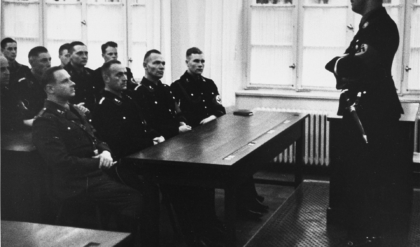
Experiments in sound or acoustic levitation are common and ongoing. Dozens of researchers have managed to use sound waves to levitate and move tiny particles and liquid droplets. Multiple vibrating plates are used to create different frequencies and move an acoustic field with particles trapped inside.
The techniques developed have not been used to lift heavy or large objects. Twenty-first century scientists do not yet know if such a thing is possible.
But there have been breakthroughs, some of which are significant enough to suggest that large-scale acoustic levitation may some day be possible.
Floating on a Wave of Sound
In two experiments, scientist have successfully levitated lightweight polystyrene balls greater in size than the wavelengths used to elevate them, which represents an important step forward in the management of the force of concentrated sound.
One of these experiments, carried out by a joint team of researchers in the UK and Brazil in 2016, lifted a 50-millimeter polystyrene ball several centimeters off the ground, where it remained suspended for as long as the sound waves were generated. Just one year later, another group of researchers working out of the University of Bristol successfully levitated a polystyrene ball of two centimeters in diameter.
These experiments might seem redundant. But researchers used two entirely different methods for achieving this feat.
The UK/Brazil team surpassed previous limits on the size of the object levitated by aligning three ultrasonic transducers (devices that convert electric energy into sound energy) in a tripod arrangement. Their combined effects created a standing (stationary) sound wave that in effect negated the force of gravity in a localized area. The University of Bristol team, on the other hand, combined a single ultrasonic transducer with a sound reflector to manufacture a standing sound wave, which maintained its stationary status after being repeatedly reflected back on itself.
These studies prove that levitation through the manipulation of sound waves is possible, and that more than one way exists to get the job done. Future experimentation may uncover even more methods for using sound to overcome the force of gravity, and some of them may be more potent than the techniques developed so far.
Was Acoustic Levitation Used to Build the Pyramids?
One theory credits the building of the pyramids and other megalithic monuments to acoustic levitation. No first-hand accounts exist, but later written testimony provides some intriguing and suggestive clues.
Abul Hasan Ali Al-Masudi, an Arab historian from the 10 th century A.D., wrote about ancient Egypt and the methods he alleges they used to move massive stones, including those used to build the pyramids. He claimed that a magic papyrus imprinted with symbols was placed under each stone, after which a metal rod was struck against the stone to initiate the levitation process. According to Al-Masudi, the stone would be guided along a fenced path with metal poles placed on each side. Some believe these poles could have been used to create high-frequency sound vibrations, which would have been responsible for creating the levitation effects.
Outside of this written testimony, which is open to interpretation, there is no direct evidence to suggest the pyramids were constructed by acoustic levitation. But the Great Pyramid of Giza does possess some extraordinary acoustic properties, demonstrating the capacity to dramatically amplify sounds generated at certain frequencies. The Egyptians who built the pyramids on the Giza plateau clearly knew a lot about sound and knew how it could be used to produce powerful effects—possibly including levitation.
Another creation that some have credited to sonic or acoustic levitation is the Coral Castle, which is located in southeastern Florida, not far from the city of Miami. The Coral Castle is a sprawling stone city built by Latvian-American immigrant Edward Leedskalnin between the years 1923 and 1951. The Coral Castle complex is constructed from nearly 1,000 tons of rock, which Leedskalnin somehow cut, shaped, lifted and maneuvered into place all by himself.
Leedskalnin refused to allow visitors or observers onsite while he was working, so there are no eyewitness accounts detailing his construction methods. There were no reports of mysterious sounds coming from the vicinity of the Coral Castle during the construction phase, but sonic levitation generally relies on the use of sound frequencies that are inaudible to humans.
In his writings and conversations, Leedskalnin never specifically identified sound as a key factor in his work. But it is known that he had an interest in radio and possessed a range of radio equipment, which he used for unknown purposes. Leedskalnin at one point told someone he knew how to tune in to “the music of the stars,” a reference that could have either literal or metaphorical connotations.
In explaining his amazing feats, the perpetually enigmatic Leedskalnin proclaimed the following:
“I have discovered the secrets of the pyramids and have found out how the Egyptians and the ancient builders in Peru, Yucutan and Asia, with only primitive tools, raised and set in place blocks of stone weighing many tons!”
There is an implication here that somehow these ancient masters had a developed a method for overcoming the force of gravity. Just exactly how Leedskalnin would have discovered the secrets of the ancients is unknown, but there are reports that he was a practicing Freemason who may have been exposed to such knowledge through his contacts in that organization.

Coral Castle. Credit: V Korostyshevskiy / Adobe Stock
Mystics of the Far East Levitate Rocks
Many anecdotal tales of acoustic levitation come from travelers in the Far East, who claim to have encountered mystics or ascetics who possessed the ability to levitate objects, sometimes with the assistance of sound.
One fascinating story came from a medical doctor named Jarl, who had been brought to a remote area of Tibet in 1939 to treat a Tibetan Buddhist holy man suffering from an unknown illness. After spending some time among the monks he eventually gained their confidence, and to show their appreciation they performed a demonstration in sonic levitation that left Dr. Jarl astounded.
In a clearing, the monks arranged 19 musical instruments (13 drums and six trumpets) in a 90-degree arc around a large, heavy stone. On cue, they began to play these instruments in unison, singing and chanting at the same time. After a few moments the stone suddenly lifted into the air, and it continued to rise until it landed on a hilltop perch approximately 250 meters above the ground.
The demonstration was repeated multiple times for Dr. Jarl, who claimed the films he made of this procedure were confiscated by the English Scientific Society, which had sponsored his trip to Asia. The drawings Dr. Jarl made of this procedure have survived to this day, although the films he allegedly made have never surfaced.

Levitating rocks. Credit: Victor Zastol’skiy / Adobe Stock
Developing the Science of Levitation
A few years ago, sonic drilling technology was developed by NASA as a means to mine materials from rocks and other hard materials encountered on space missions. This helped boost interest in the capacity of sound to generate force, including the power necessary to levitate physical objects.
Compared to stories of heavy stones lifted high into the air by chanting and drum-playing monks, the achievements of 21 st century scientists may not seem impressive. But they do show that sound waves can be used to accomplish amazing things, and controlled experiments are more authoritative than unproven anecdotes from the distant past.
Acoustic levitation is real, and as scientists learn more about how it works their ability to harness it will likely advance by leaps and bounds.




